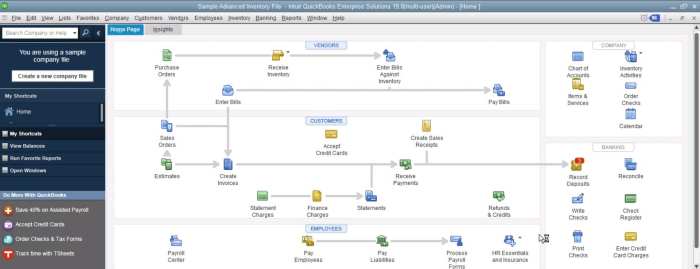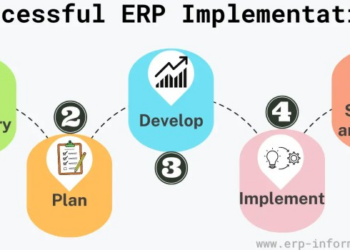Embark on a journey into the world of QuickBooks ERP, a robust software solution that revolutionizes how businesses manage their operations and finances. Discover the key aspects that make QuickBooks ERP a game-changer in the industry.
Overview of QuickBooks ERP

QuickBooks ERP is a comprehensive business management software solution designed to help organizations streamline their operations, manage finances, track inventory, and facilitate decision-making processes. It integrates various functions such as accounting, inventory management, sales, and human resources into a single platform, providing real-time insights and enhancing overall efficiency.
Key Features of QuickBooks ERP
- Financial Management: QuickBooks ERP offers robust financial tools for budgeting, forecasting, and financial reporting.
- Inventory Management: Users can track inventory levels, monitor stock movements, and optimize supply chain processes.
- Sales and Customer Management: The software allows businesses to manage sales orders, track customer interactions, and improve customer relationships.
- Human Resources: QuickBooks ERP includes HR management features such as payroll processing, employee scheduling, and performance tracking.
Examples of Industries that Benefit from QuickBooks ERP
- Manufacturing: Companies in the manufacturing sector can utilize QuickBooks ERP to streamline production processes, manage inventory effectively, and optimize resource allocation.
- Retail: Retail businesses can benefit from the software's sales and inventory management capabilities to enhance customer service and improve operational efficiency.
- Services: Service-based industries can leverage QuickBooks ERP to automate billing processes, track project expenses, and analyze profitability.
Integration with QuickBooks ERP
Integrating QuickBooks ERP with other software is a crucial step in streamlining business processes and improving efficiency. By connecting QuickBooks ERP with existing systems, businesses can achieve a seamless flow of data and information across different departments.
Benefits of Integrating QuickBooks ERP
- Improved data accuracy: Integrating QuickBooks ERP with other software eliminates manual data entry errors, ensuring that information is consistent and up-to-date.
- Increased productivity: By automating tasks and workflows through integration, employees can focus on more strategic activities, leading to improved productivity.
- Enhanced visibility: Integration allows for real-time access to key business data, enabling better decision-making and resource allocation.
- Cost savings: Streamlining processes through integration can reduce operational costs and eliminate the need for duplicate data entry.
Popular Integrations with QuickBooks ERP
- QuickBooks Online: Integration with QuickBooks Online allows for easy synchronization of financial data, providing a comprehensive view of the business's financial health.
- Salesforce: Integrating QuickBooks ERP with Salesforce enables seamless management of customer data, sales orders, and invoices, improving customer relationship management.
- Shopify: By integrating QuickBooks ERP with Shopify, businesses can automate order processing, inventory management, and financial reporting, enhancing e-commerce operations.
Customization Options in QuickBooks ERP
Customization is a key feature of QuickBooks ERP that allows businesses to tailor the software to meet their specific needs and requirements. This flexibility enables companies to optimize their workflows, improve efficiency, and enhance overall productivity.
Custom Fields and Forms
QuickBooks ERP offers the ability to create custom fields and forms, allowing businesses to capture and track unique data points that are relevant to their operations. For example, a manufacturing company can create custom fields to track specific production metrics or quality control data within the system.
User Permissions and Access Control
Businesses can customize user permissions and access control settings in QuickBooks ERP to ensure that sensitive information is only accessible to authorized personnel. This feature helps companies maintain data security and compliance with industry regulations.
Reports and Dashboards
QuickBooks ERP provides a range of customization options for reports and dashboards, allowing businesses to create personalized views of their data. Companies can choose to display key performance indicators, financial metrics, and other relevant information in a format that is most useful for their decision-making processes.
Workflow Automation
Customization in QuickBooks ERP extends to workflow automation, enabling businesses to streamline repetitive tasks and processes. By setting up custom workflows, companies can reduce manual intervention, minimize errors, and improve the overall efficiency of their operations.
Integrations and Add-Ons
Another aspect of customization in QuickBooks ERP is the ability to integrate with third-party applications and add-ons. This feature allows businesses to extend the functionality of the software and integrate additional tools that are essential to their operations.
Reporting and Analytics in QuickBooks ERP
Reporting and analytics play a crucial role in helping businesses make informed decisions and track their performance. In QuickBooks ERP, users have access to a variety of reporting features and analytics tools to streamline their financial processes and gain valuable insights.
Reporting Features in QuickBooks ERP
QuickBooks ERP offers a range of reporting features that allow users to generate customizable reports based on their specific needs. Some key reporting features include:
- Financial Reports: Users can generate standard financial reports such as balance sheets, income statements, and cash flow statements to get a comprehensive view of their financial health.
- Sales Reports: Businesses can track sales performance, monitor sales trends, and analyze customer behavior through detailed sales reports.
- Inventory Reports: Users can manage inventory levels, track stock movements, and optimize inventory management with inventory reports.
- Custom Reports: QuickBooks ERP enables users to create custom reports tailored to their unique business requirements, providing greater flexibility and insight.
Leveraging Analytics in QuickBooks ERP
Businesses can leverage analytics within QuickBooks ERP to gain valuable insights and drive strategic decision-making. By analyzing data trends and patterns, users can identify opportunities for growth, optimize processes, and improve overall efficiency. Analytics in QuickBooks ERP can help businesses:
- Identify Cost-saving Opportunities
- Forecast Revenue and Expenses
- Analyze Customer Behavior
- Monitor Key Performance Indicators
Key Performance Indicators in QuickBooks ERP
Key performance indicators (KPIs) are essential metrics that businesses can track using QuickBooks ERP to measure performance and progress towards business goals. Some examples of KPIs that can be tracked include:
- Profit Margin
- Return on Investment (ROI)
- Customer Acquisition Cost
- Inventory Turnover Ratio
- Sales Growth Rate
Migration to QuickBooks ERP
When migrating to QuickBooks ERP, it is essential to follow a systematic approach to ensure a smooth transition. Below are the steps involved in migrating to QuickBooks ERP, common challenges faced during the migration process, and tips for a successful transition.
Steps Involved in Migration
- Assessment of Current Systems: Evaluate your existing systems, processes, and data to determine what needs to be migrated to QuickBooks ERP.
- Data Preparation: Cleanse and organize your data to ensure accuracy and completeness before migration.
- Customization and Configuration: Customize QuickBooks ERP to align with your business needs and configure settings accordingly.
- Training and Testing: Provide training to users on the new system and conduct thorough testing to identify and resolve any issues.
- Go-Live and Support: Go live with QuickBooks ERP, provide ongoing support, and monitor performance to ensure a successful transition.
Common Challenges Faced
- Data Integrity Issues: Inaccurate or incomplete data can lead to errors during migration.
- Lack of User Training: Insufficient training for users can result in resistance to change and adoption issues.
- Integration Problems: Difficulty in integrating QuickBooks ERP with existing systems and applications.
- Technical Glitches: Unexpected technical issues can disrupt the migration process and impact operations.
Tips for a Successful Transition
- Plan Ahead: Develop a detailed migration plan with clear timelines and responsibilities.
- Engage Stakeholders: Involve key stakeholders from the beginning to gain buy-in and support for the migration.
- Communicate Effectively: Keep all stakeholders informed about the migration process, updates, and potential challenges.
- Monitor Progress: Regularly track the progress of the migration and address any issues promptly.
- Seek Expert Assistance: Consider hiring consultants or experts to guide you through the migration process and ensure a successful transition.
Final Wrap-Up
In conclusion, QuickBooks ERP offers a dynamic platform for businesses to streamline their processes, enhance decision-making, and drive growth. Embrace the potential of QuickBooks ERP to elevate your business to new heights of success.
Top FAQs
What are the key features of QuickBooks ERP?
QuickBooks ERP offers comprehensive financial management, inventory tracking, customizable reporting, and seamless integration capabilities.
How can businesses tailor QuickBooks ERP to their specific needs?
Businesses can customize workflows, reports, and dashboards to align with their unique requirements and processes.
What are some common challenges faced during the migration to QuickBooks ERP?
Common challenges include data migration issues, training requirements for employees, and ensuring system compatibility.











